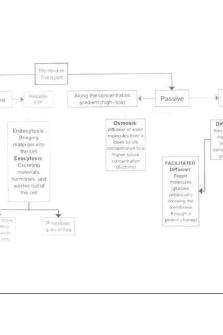Lab Flow Chart 1 PDF

| Title | Lab Flow Chart 1 |
|---|---|
| Author | CC Bobber |
| Course | General Biology Laboratory I. 1.0 Credit. |
| Institution | Johns Hopkins University |
| Pages | 1 |
| File Size | 34.5 KB |
| File Type | |
| Total Downloads | 80 |
| Total Views | 150 |
Summary
flowchart summary...
Description
General Biology 1 Lab Dr. Pearlman Flow Chart Week #3 09/10/19
GOALS: 1) investigating different ecosystems within the Homewood Campus (defined by the location of trees) 2) Identifying and determining different tree population and the most prevalent tree species across sites 3) culturing bacteria from the collected soil across multiple sites. Part A: Observe Growth of E. coli Plates, Collect Materials for Field Work In this part, we will simply record the growth and any changes happened in our E. Coli plates we created last week. Later instruction will follow during the lab meeting via Lab Assignment Part B: Collect Data and Samples near Stoney Run Footbridge & Part C: Collect Data and Samples in the Clark-Hodson Forest First, we will make notes on the trees we observe across both areas (primarily the five species we were introduced to last week). Then we will add the distribution areas of these trees and other landmark information (like paths, etc.) into the blank map provided in the lab assignment pages. We will also mark the location of the sample we acquired into the map. For the sample collection, I will be leaving it to the hands of my lab partner (as I am excused from this work). But he will come back with a small sample of soil in a 50 ml plastic tube and give me details of the quality of the soil (ex: location of the soil collected and general appearance of the soil). Part D: Dilute Soil Samples and Plate Bacteria First thing would be to diluting the collected bacteria population in saline solution. In process, we will be putting about 0.1 mL of soil in a new, sterile 50 mL tube (via utilizing microcentrifuge tube) and pouring sterile saline solution into the tube until it marks the 10 mL mark. Then we will shake and label it “1:100 dilution”. Using new equipments of same kind, create another tube with “1:10,000 dilution”. Next, transfer 1 mL of this solution this time into another 50 mL tube and repeat the previous steps to create “1:100,000 dilution”. After that, plate 100 uL of 1:10,000 and 1:100,000 dilution on the nutrient agar plate retrospectively. If needed, use directions from last week’s lab manual to complete this process. Incubate at room temperature for one week. Wipe the station with disinfectant solution, wash hands, and leave....
Similar Free PDFs

Lab 1 Flow Chart
- 6 Pages

Lab Flow Chart 1
- 1 Pages

Lab Flow Chart 5
- 2 Pages

Lab Flow Chart #4
- 1 Pages

Flow chart Process Flow
- 2 Pages

Flow Chart
- 2 Pages

Flow Chart
- 6 Pages

Flow chart -registered land
- 1 Pages

Algorithm and Flow Chart
- 20 Pages

Contracts Flow Chart - Notes
- 4 Pages

Partnerhips flow chart
- 5 Pages

Isomerism Flow Chart
- 1 Pages

Torts flow chart
- 2 Pages

Membrane Transport Flow Chart
- 1 Pages

Homicide Flow Chart
- 1 Pages
Popular Institutions
- Tinajero National High School - Annex
- Politeknik Caltex Riau
- Yokohama City University
- SGT University
- University of Al-Qadisiyah
- Divine Word College of Vigan
- Techniek College Rotterdam
- Universidade de Santiago
- Universiti Teknologi MARA Cawangan Johor Kampus Pasir Gudang
- Poltekkes Kemenkes Yogyakarta
- Baguio City National High School
- Colegio san marcos
- preparatoria uno
- Centro de Bachillerato Tecnológico Industrial y de Servicios No. 107
- Dalian Maritime University
- Quang Trung Secondary School
- Colegio Tecnológico en Informática
- Corporación Regional de Educación Superior
- Grupo CEDVA
- Dar Al Uloom University
- Centro de Estudios Preuniversitarios de la Universidad Nacional de Ingeniería
- 上智大学
- Aakash International School, Nuna Majara
- San Felipe Neri Catholic School
- Kang Chiao International School - New Taipei City
- Misamis Occidental National High School
- Institución Educativa Escuela Normal Juan Ladrilleros
- Kolehiyo ng Pantukan
- Batanes State College
- Instituto Continental
- Sekolah Menengah Kejuruan Kesehatan Kaltara (Tarakan)
- Colegio de La Inmaculada Concepcion - Cebu
